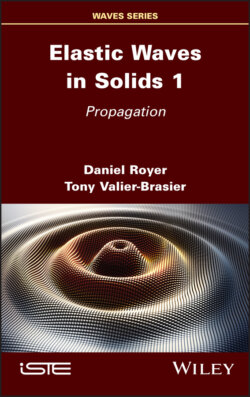Elastic Waves in Solids 1

Реклама. ООО «ЛитРес», ИНН: 7719571260.
Оглавление
Daniel Royer. Elastic Waves in Solids 1
Table of Contents
List of Illustrations
List of Tables
Guide
Pages
Elastic Waves in Solids 1. Propagation
Preface
List of Main Symbols
1. Propagation in an Unbounded Solid
1.1. Reviewing the mechanics of continuous media
1.1.1. Conservation equations
1.1.1.1. Integral equations
1.1.1.2. Local equations
1.1.2. Kinematics of continuous media
1.1.3. Poynting’s theorem: energy balance
1.1.4. Stress–strain relationship: Maxwell relations
1.2. Isotropic solid
1.2.1. Constitutive equations
1.2.2. Equations of propagation, wave decoupling
1.2.2.1. Helmholtz decomposition
1.2.2.2. Velocity of bulk waves
1.2.3. Traveling, plane, sinusoidal waves
1.2.3.1. Traveling wave
1.2.3.2. Plane wave
1.2.3.3. Complex representation
1.2.4. Polarization
1.2.5. Acoustic intensity
1.2.6. Cylindrical and spherical waves
1.2.6.1. Cylindrical waves
1.2.6.2. Spherical waves
1.2.6.2.1. Longitudinal wave
1.2.6.2.2. Transverse wave
1.3. Anisotropic solid
1.3.1. Symmetry and elasticity tensor
1.3.2. Propagation equation, phase velocity, polarization
1.3.3. Propagation in an orthotropic material
1.3.4. Group velocity and energy velocity
1.3.5. Slowness surface and wave surface
1.3.5.1. Anisotropy factor
1.3.5.2. 3D slowness surfaces
1.4. Piezoelectric solid
1.4.1. Constitutive equations
1.4.2. Reduction in the number of independent piezoelectric constants
1.4.3. Plane waves in a piezoelectric crystal
1.4.3.1. Propagation in a material of cubic symmetry
1.4.3.2. Electromechanical coupling coefficient
1.4.3.3. Propagation in a crystal of trigonal system
1.5. Viscoelastic media
1.5.1. Constitutive equation of linear viscoelasticity
1.5.2. Simple rheological models
1.5.3. Velocity and attenuation in a viscoelastic medium
1.5.4. Time–temperature superposition principle
1.5.5. Newtonian fluid
2. Reflection and Transmission at an Interface
2.1. Boundary conditions
2.2. Direction and polarization of reflected and transmitted waves
2.2.1. Graphical construction
2.2.2. Wave decoupling
2.2.2.1. General case
2.2.2.2. Isotropic case
2.2.3. Critical angle, evanescent wave and total reflection
2.2.4. Conservation of energy
2.3. Isotropic solid: transverse horizontal wave
2.3.1. Reflection and transmission between two solids
2.3.2. Plate between two solids, impedance matching
2.4. Isotropic media: longitudinal and transverse vertical waves
2.4.1. Reflection on a free surface
2.4.1.1. Incident longitudinal wave
2.4.1.2. Incident transverse vertical wave
2.4.2. Solid–fluid interface
2.4.2.1. Incident longitudinal wave in the solid
2.4.2.2. Incident transverse vertical wave in the solid
2.4.2.3. Incident longitudinal wave in the fluid
2.4.2.4. Interaction of a plane wave with an immersed plate
2.4.2.4.1. Velocity measurements by time-of-flight
2.4.2.4.2. Phase velocity and attenuation measurements
2.5. Anisotropic medium: diffraction matrix
2.5.1. Analytical resolution
2.5.2. Expression for the stresses
2.5.3. Sorting the solutions
2.5.4. Considerations of symmetry
2.5.5. Reflection and transmission coefficients, interface waves
2.5.5.1. Diffraction matrix
2.5.5.2. Reflection on a free surface
2.5.5.3. Interface and surface waves
2.5.6. Interface between an orthotropic solid and an isotropic solid
3. Surface Waves and Interface Waves
3.1. Surface waves
3.1.1. Isotropic solid: Rayleigh wave
3.1.1.1. Method of potentials
3.1.1.2. Mechanical displacement and stresses
3.1.1.3. Displacement amplitude and power
3.1.2. Anisotropic solid
3.1.2.1. Method of partial waves
3.1.2.2. Solid with an orthotropic symmetry
3.1.2.3. Influence of the anisotropy factor
3.1.2.4. Pseudo-surface acoustic wave
3.1.3. Piezoelectric crystal
3.1.3.1. Search procedure, wave decoupling
3.1.3.2. Electrical boundary conditions, surface permittivity
3.1.3.3. Electromechanical coupling coefficient
3.1.3.4. Amplitude of electric potential and power
3.1.3.5. Characteristics of the main materials
3.2. Interface waves
3.2.1. Isotropic solid-perfect fluid interface
3.2.1.1. Characteristic equation
3.2.1.2. Scholte wave
3.2.1.3. Leaky Rayleigh wave
3.2.2. Interface between two isotropic solids
3.2.2.1. Perfect interface: Stoneley wave
3.2.2.2. Degraded interface
3.3. Bleustein–Gulyaev wave
4. Guided Elastic Waves
4.1. Waveguide, group velocity
4.1.1. Elementary planar waveguide
4.1.2. Velocity of a wave packet
4.1.3. Propagation of a Gaussian pulse
4.2. Transverse horizontal waves
4.2.1. Guided TH modes
4.2.2. Love wave
4.2.3. Love wave in an inhomogeneous medium
4.3. Lamb waves
4.3.1. Free isotropic plate
4.3.1.1. Rayleigh–Lamb equations
4.3.1.2. Dispersion curves
4.3.1.3. Behavior at low and high frequencies
4.3.1.3.1. Modes without a cut-off frequency
4.3.1.3.2. Modes with a cut-off frequency
4.3.1.3.3. High-frequency behavior
4.3.1.4. Zero group velocity modes
4.3.1.4.1. Origin of ZGV modes
4.3.1.4.2. Selection rules
4.3.1.4.3. Range of existence
4.3.1.5. Influence of Poisson’s ratio
4.3.1.6. Lamé modes
4.3.1.7. Plate with finite dimensions
4.3.1.7.1. Edge resonance
4.3.1.7.2. Waves guided by a ribbon
4.3.2. Isotropic plate immersed in a fluid
4.3.3. Free anisotropic plate
4.3.3.1. Partial wave method
4.3.3.2. Solid with a monoclinic symmetry
4.3.3.3. Solid with an orthorhombic symmetry
4.3.3.4. Composite material
4.3.3.5. Group velocity and slowness curves
4.4. Cylindrical guides
4.4.1. Compressional modes
4.4.2. Flexural modes
4.4.3. Torsional modes
4.4.4. Tubular waveguide
Appendix 1. Differential Operators in Cylindrical and Spherical Coordinates
A1.1. Cylindrical coordinates
A1.2. Spherical coordinates
Appendix 2. Symmetry and Tensors
A2.1. Crystalline structure
A2.1.1. Lattice and atomic structure
A2.1.2. Rows, lattice planes and cells
A2.1.2.1. Rows
A2.1.2.2. Lattice planes and Miller indices
A2.1.2.3. Cells
A2.2. Point symmetry of crystals
A2.2.1. Point symmetry operations
A2.2.1.1. Stereographic projection
A2.2.1.2. Equivalence relations
A2.2.2. Point symmetry of lattices: the seven crystal systems
A2.2.3. The 32-point symmetry classes of crystals
A2.3. Representation of physical properties of crystals by tensors
A2.3.1. Change of orthonormal reference axes
A2.3.2. Definition of a tensor
A2.4. Reduction of the number of independent components imposed by the symmetry elements
A2.4.1. Matrices of point symmetry operations
A2.4.2. Effect of a center of symmetry
A2.5. Reduction of the number of independent elastic constants
A2.5.1. Crystals with at least one binary axis
A2.5.2. Crystals with a principal axis An (n > 2)
Appendix 3. Transport of Energy
A3.1. Energy balance
A3.2. Harmonic case
A3.3. Susceptance and free modes
References. Chapter 1
Chapter 2
Chapter 3
Chapter 4
Appendixes
General bibliography
Index
WILEY END USER LICENSE AGREEMENT
Отрывок из книги
Series Editors Pierre-Noël Favennec† and Frédérique de Fornel
.....
u : mechanical displacement vector.
U : internal energy per unit volume.
.....